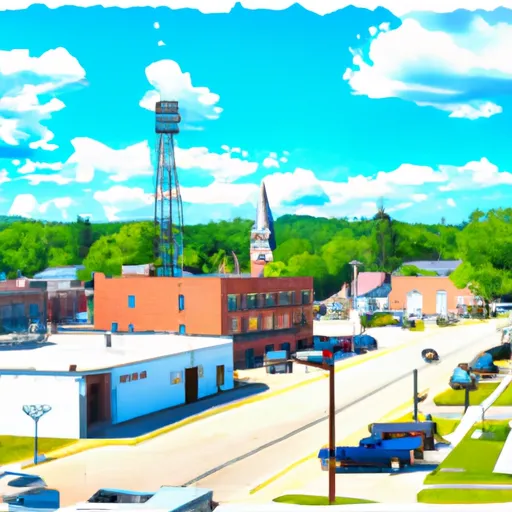-
 Snoflo Premium
Snoflo Premium
Get unlimited access to all our content
With no Ad interruptions! - Start Your Free Trial Login with existing account
Topinabee
Eden Index
Climate
6.4
•
Recreation
6.5
•
Community
1.4
•
Safeguard
5.2/10

Topinabee is a small village located in northern Michigan, specifically in Cheboygan County. The climate in Topinabee is classified as humid continental, characterized by cold winters and warm summers. Average temperatures range from the mid-20s Fahrenheit (-4°C) in winter to the mid-70s Fahrenheit (24°C) in summer. Snowfall is common during winter months, providing opportunities for winter sports like skiing and snowboarding.
Situated on the shore of Mullett Lake, Topinabee boasts beautiful hydrology constituents. Mullett Lake is the third-largest inland lake in Michigan, offering excellent fishing, boating, and swimming opportunities. Additionally, the nearby Cheboygan River provides opportunities for kayaking and canoeing, allowing visitors to explore the scenic waterways.
Outdoor recreation opportunities in Topinabee are abundant. The area is known for its picturesque hiking and biking trails, offering opportunities to explore the surrounding natural beauty. There are also several nearby state parks, such as Burt Lake State Park and Aloha State Park, which provide camping, hiking, and wildlife viewing opportunities.
In summary, Topinabee, Michigan offers a picturesque setting with its beautiful hydrology constituents, providing ample opportunities for outdoor activities throughout the year.
What is the Eden Index?
The Snoflo Eden Index serves as a comprehensive rating system for regions, evaluating their desirability through a holistic assessment of climate health, outdoor recreation opportunities, and natural disaster risk, acknowledging the profound impact of these factors on livability and well-being.
Climate Health Indicator (CHI): 6.4
Topinabee receives approximately
790mm of rain per year,
with humidity levels near 83%
and air temperatures averaging around
7°C.
Topinabee has a plant hardyness factor of
5, meaning
plants and agriculture in this region thrive during a short period during spring and early summer. Most
plants will die off during the colder winter months.
By considering the ideal temperature range, reliable water supplies, clean air, and stable seasonal rain or snowpacks, the Climate Health Indicator (CHI) underscores the significance of a healthy climate as the foundation for quality living.
A healthy climate is paramount for ensuring a high quality of life and livability in a region, fostering both physical well-being and environmental harmony. This can be characterized by ideal temperatures, reliable access to water supplies, clean air, and consistent seasonal rain or snowpacks.
Weather Forecast
Streamflow Conditions
Northwestern Lake Huron
Area Rivers
Northwestern Lake Huron
Snowpack Depths
Northwestern Lake Huron
Reservoir Storage Capacity
Northwestern Lake Huron
Groundwater Levels
Recreational Opportunity Index (ROI): 6.5
The Recreational Opportunity Index (ROI) recognizes the value of outdoor recreational options, such as parks, hiking trails, camping sites, and fishing spots, while acknowledging that climate plays a pivotal role in ensuring the comfort and consistency of these experiences.
Access to outdoor recreational opportunities, encompassing activities such as parks, hiking, camping, and fishing, is crucial for overall well-being, and the climate plays a pivotal role in enabling and enhancing these experiences, ensuring that individuals can engage in nature-based activities comfortably and consistently.
Camping Areas
| Campground | Campsites | Reservations | Toilets | Showers | Elevation |
|---|---|---|---|---|---|
| Brimley State Park | 235 | 628 ft | |||
| Bay View | 24 | 622 ft | |||
| Beach - Pancake Bay Provincial Park | 236 | 614 ft | |||
| Agawa Bay - Lake Superior Provincial Park | 147 | 620 ft | |||
| Crescent Lake - Lake Superior Provincial Park | 20 | 1,184 ft | |||
| Hilltop - Pancake Bay Provincial Park | 89 | 657 ft | |||
| Monocle Lake Rec Area | 39 | 641 ft | |||
| Sherman City Park | None | 611 ft | |||
| Kinross RV Park West | 52 | 795 ft | |||
| Kinross RV Park East | 64 | 781 ft |
Nearby Ski Areas
Catastrophe Safeguard Index (CSI):
The Catastrophe Safeguard Index (CSI) recognizes that natural disaster risk, encompassing floods, fires, hurricanes, and tornadoes, can drastically affect safety and the overall appeal of an area.
The level of natural disaster risk in a region significantly affects safety and the overall livability, with climate change amplifying these risks by potentially increasing the frequency and intensity of events like floods, fires, hurricanes, and tornadoes, thereby posing substantial challenges to community resilience and well-being.
Community Resilience Indicator (CRI): 1.4
The Community Resilience Indicator (CRI) recognizes that education, healthcare, and socioeconomics are crucial to the well-being of a region. The CRI acknowledges the profound impact of these elements on residents' overall quality of life. By evaluating educational resources, healthcare accessibility, and economic inclusivity, the index captures the essential aspects that contribute to a thriving community, fostering resident satisfaction, equity, and social cohesion.

